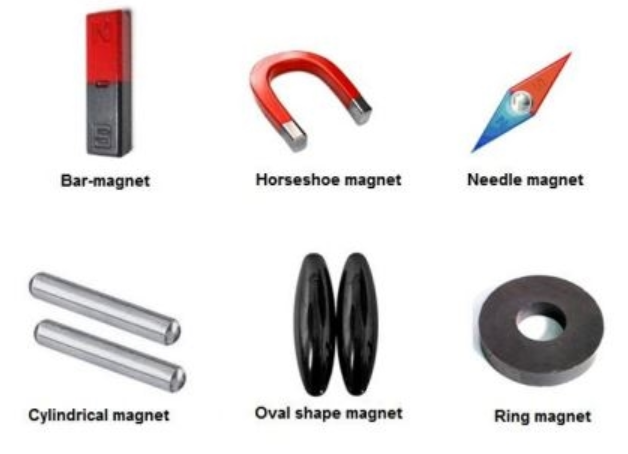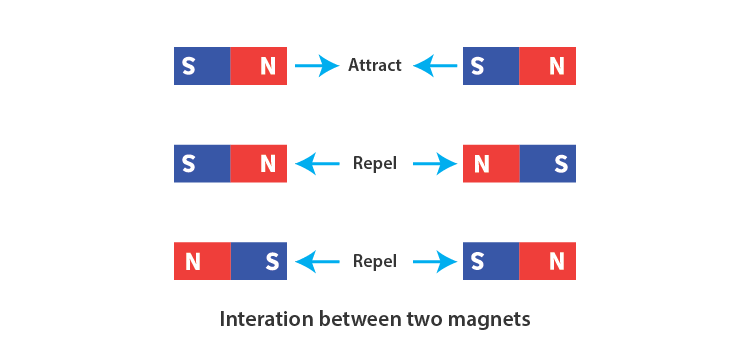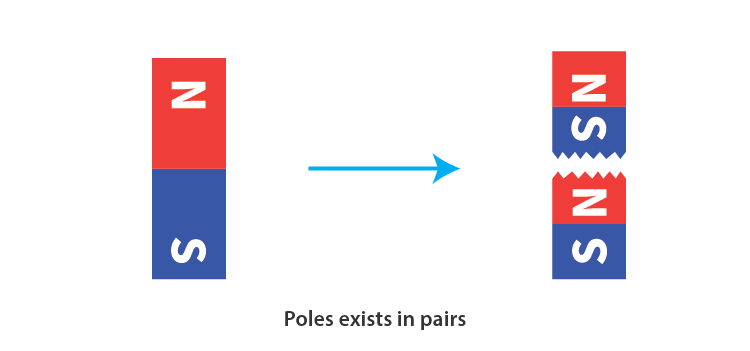Concepts
- Discovery of magnet
Magnet was discovered by an ancient Greek shepherd; named Magnes around 2800 years ago. Once; while he was fiddling with his stick, the metallic end of the stick got stuck with the rocks. Those rocks contained the natural magnet, magnetite. - Magnet
An object which attracts magnetic materials; like iron, cobalt and nickel; is called magnet. - Natural Magnet: Magnet which is found naturally is called natural magnet.
- Artificial Magnet: Magnet which is made by humans is called artificial magnet.
- Types of Magnet
Magnets are made in different shapes and they are named according to the shape, e.g. bar magnet, dumb-bell shaped magnet, horse-shoe magnet, cylindrical magnet, etc.

- Magnetic Materials: Materials which are attracted towards a magnet are called magnetic materials, e.g. iron, nickel and cobalt.
- Non-magnetic Materials: Materials which are not attracted towards a magnet are called non-magnetic materials, e.g. aluminium, zinc, wood, rubber, etc.
- Poles of Magnet
A magnet has two poles, north pole and south pole. The magnetic power is concentrated at the geometric ends of a magnet. When a bar magnet is suspended to move freely, it always points in the north-south direction. The north pole of the magnet points towards the north and the south pole of the magnet points towards the south.

- A Magnetic field is defined as the region around a magnet within which the magnetic force acts. Being strongest at the poles, this is why magnetic objects get attracted to the ends of the magnet.
- Interaction between poles of magnet
- Like poles repel each other. This means when north pole of a magnet is brought near the north pole of another magnet, both repel each other. The same holds true for the south poles of two magnets.
- Unlike poles attract each other. This means when north pole of a magnet is brought near the south pole of another magnet, both attract each other.

- Inseparable Poles
Magnetic poles always exist in pairs.
If you cut a bar magnet in half, it forms 4 poles, each half having a north and a south pole.

- Finding directions using magnet
The end of the magnet that points towards north is called it's North Pole. The other end that points towards south is called South Pole.

- Magnetic compass is a device developed based on the above property. It composed of a small box with a glass top. The magnetic needle is placed on a pivot around which it can rotate freely.
- Making Your Own Magnet
With the help of a permanent magnet you can change a piece of iron into a magnet. For this, you need to place the iron piece on a flat surface. Then rub the permanent magnet on the iron piece for many times. Your hand movement should always be in the same direction, while doing this. After some time, the iron
piece would attain magnetic property. - Storing a magnet
- Bar magnets should be kept in pairs. Their unlike poles should be kept on the same side. A wooden piece must be placed between them. A piece of soft iron should be placed at their ends.
- For storing a horse-shoe magnet, you should place a piece of iron across the two poles.
- Magnets should be kept away from speakers, CD, television, music system, computer, etc.
Permanent magnets and temporary magnets:
| Permanent magnets | Temporary magnets |
| These are magnets that once made remain as magnets for a long period of time. | These are magnets that once made remain as a magnet only for a short interval of time. |
| Steel, cobalt steel, alnico and ticanol are some of the materials that are used for making permanent magnets | Soft iron and nickel are two of the materials used for making temporary magnets. |
Magnetic and non-magnetic materials:
| Magnetic materials | Non magnetic materials |
| Materials which get attracted towards a magnet are called magnetic materials. | Materials that do not get attracted towards a magnet are called non magnetic materials. |
| Examples: Iron, Steel, cobalt, nickel etc. | Examples: Paper, wood, straws etc. |
Match the following items given in Column A with that in Column B:
| Column A | Column B |
| (a) Magnetite | (i) Non-magnetic substances |
| (b) Iron, nickel, cobalt | (ii) Used to find out N-S directions |
| (c) Leather, plastic, wax | (iii) Attract each other |
| (d) Lodestone | (iv) Natural magnet |
| (e) Compass | (v) Repel each other |
| (f) Like poles of two magnets | (vi) Discovered magnet accidently |
| (g) Opposite poles of two magnets | (vii) Magnetic, substances |
| (h) Magnus | (viii) Name of first magnet |
Answer:
| Column A | Column B |
| (a) Magnetite | (iv) Natural magnet |
| (b) Iron, nickel, cobalt | (vii) Magnetic substances |
| (c) Leather, plastic, wax | (i) Non-magnetic substances |
| (d) Lodestone | (viii) Name of first magnet |
| (e) Compass | (ii) Used to find out N-S directions |
| (f) Like poles of two magnets | (v) Repel each other |
| (g) Opposite poles of two magnets | (iii) Attract each other |
| (h) Magnus | (vi) Discovered magnet accidently |

